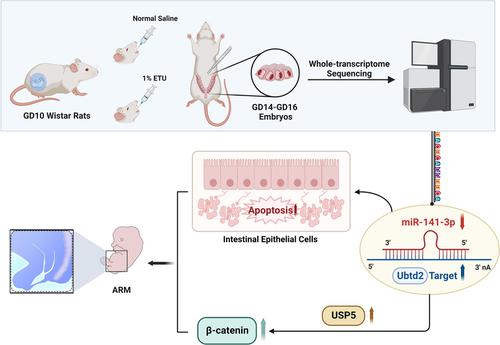当前位置:
X-MOL 学术
›
Ann. N. Y. Acad. Sci.
›
论文详情
Our official English website, www.x-mol.net, welcomes your
feedback! (Note: you will need to create a separate account there.)
miR-141-3p affects β-catenin signaling and apoptosis by targeting Ubtd2 in rats with anorectal malformations
Annals of the New York Academy of Sciences ( IF 4.1 ) Pub Date : 2022-11-03 , DOI: 10.1111/nyas.14924 Chen Yi Wang 1, 2 , Si Ying Li 1, 2 , Yun Xia Xiao 1, 2 , Lin Zhen 1, 2 , Xiao Gao Wei 1, 2 , Xiao Bing Tang 1 , Zheng Wei Yuan 2 , Yu Zuo Bai 1
Annals of the New York Academy of Sciences ( IF 4.1 ) Pub Date : 2022-11-03 , DOI: 10.1111/nyas.14924 Chen Yi Wang 1, 2 , Si Ying Li 1, 2 , Yun Xia Xiao 1, 2 , Lin Zhen 1, 2 , Xiao Gao Wei 1, 2 , Xiao Bing Tang 1 , Zheng Wei Yuan 2 , Yu Zuo Bai 1
Affiliation

|
Anorectal malformations (ARMs) are the most common gastrointestinal malformations. miR-141-3p was obtained from whole-transcriptome sequencing, and Ub domain-containing protein 2 (Ubtd2) was predicted as the target gene. An ARM rat model was induced using ethylenethiourea. Fluorescence in situ hybridization and immunofluorescence were used to detect the spatiotemporal expression of miR-141-3p and Ubtd2, respectively. A dual-luciferase reporter assay confirmed their targeting relationship, and cell proliferation and apoptosis were investigated after transfection in the intestinal epithelium (IEC-6). Additionally, western blotting and co-immunoprecipitation were used to examine the protein levels and the endogenous binding relationship. miR-141-3p was downregulated in the ARM group, whereas Ubtd2 increased and colocalized with TUNEL-positive cells. After miR-141-3p inhibition, protein expression of USP5 and β-catenin was affected via Ubtd2, and USP5 could bind to both Ubtd2 and β-catenin. Flow cytometry analysis and caspase 3/7 staining demonstrated that downregulated miR-141-3p promoted cell apoptosis through Ubtd2. In summary, targeting Ubtd2 decreased in miR-141-3p and promoted apoptosis of intestinal epithelium and regulated β-catenin expression. This may cause aberrant apoptosis during hindgut development and mediate the imbalance of β-catenin signaling in the cloaca, further affecting the occurrence of ARMs.
中文翻译:

miR-141-3p 通过靶向肛门直肠畸形大鼠的 Ubtd2 影响 β-catenin 信号和细胞凋亡
肛门直肠畸形 (ARM) 是最常见的胃肠道畸形。全转录组测序获得miR-141-3p,预测含Ub结构域的蛋白2(Ubtd2)为靶基因。使用亚乙基硫脲诱导 ARM 大鼠模型。原位荧光杂交和免疫荧光分别用于检测miR-141-3p和Ubtd2的时空表达。双荧光素酶报告基因测定证实了它们的靶向关系,并且在肠上皮细胞转染后研究了细胞增殖和凋亡 (IEC-6)。此外,蛋白质印迹法和共免疫沉淀法用于检查蛋白质水平和内源性结合关系。miR-141-3p 在 ARM 组中下调,而 Ubtd2 增加并与 TUNEL 阳性细胞共定位。抑制 miR-141-3p 后,USP5 和 β-catenin 的蛋白表达通过 Ubtd2 受到影响,USP5 可以与 Ubtd2 和 β-catenin 结合。流式细胞术分析和 caspase 3/7 染色表明下调的 miR-141-3p 通过 Ubtd2 促进细胞凋亡。总之,靶向 Ubtd2 的 miR-141-3p 减少并促进肠上皮细胞凋亡并调节 β-catenin 表达。这可能会导致后肠发育过程中的异常细胞凋亡,并介导泄殖腔中 β-catenin 信号通路的失衡,进一步影响 ARMs 的发生。
更新日期:2022-11-03
中文翻译:

miR-141-3p 通过靶向肛门直肠畸形大鼠的 Ubtd2 影响 β-catenin 信号和细胞凋亡
肛门直肠畸形 (ARM) 是最常见的胃肠道畸形。全转录组测序获得miR-141-3p,预测含Ub结构域的蛋白2(Ubtd2)为靶基因。使用亚乙基硫脲诱导 ARM 大鼠模型。原位荧光杂交和免疫荧光分别用于检测miR-141-3p和Ubtd2的时空表达。双荧光素酶报告基因测定证实了它们的靶向关系,并且在肠上皮细胞转染后研究了细胞增殖和凋亡 (IEC-6)。此外,蛋白质印迹法和共免疫沉淀法用于检查蛋白质水平和内源性结合关系。miR-141-3p 在 ARM 组中下调,而 Ubtd2 增加并与 TUNEL 阳性细胞共定位。抑制 miR-141-3p 后,USP5 和 β-catenin 的蛋白表达通过 Ubtd2 受到影响,USP5 可以与 Ubtd2 和 β-catenin 结合。流式细胞术分析和 caspase 3/7 染色表明下调的 miR-141-3p 通过 Ubtd2 促进细胞凋亡。总之,靶向 Ubtd2 的 miR-141-3p 减少并促进肠上皮细胞凋亡并调节 β-catenin 表达。这可能会导致后肠发育过程中的异常细胞凋亡,并介导泄殖腔中 β-catenin 信号通路的失衡,进一步影响 ARMs 的发生。











































 京公网安备 11010802027423号
京公网安备 11010802027423号